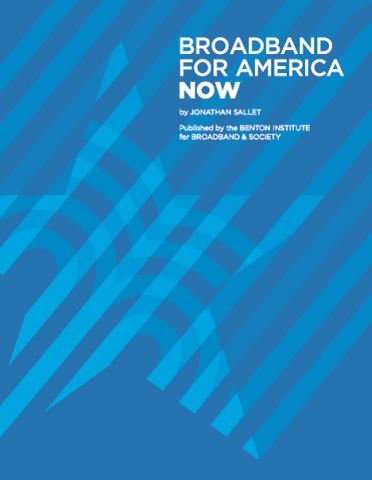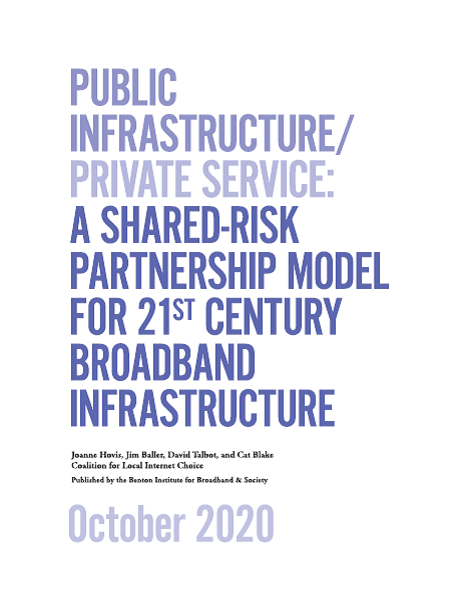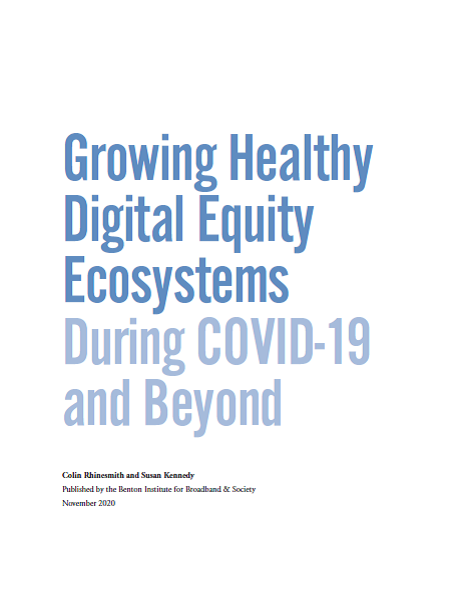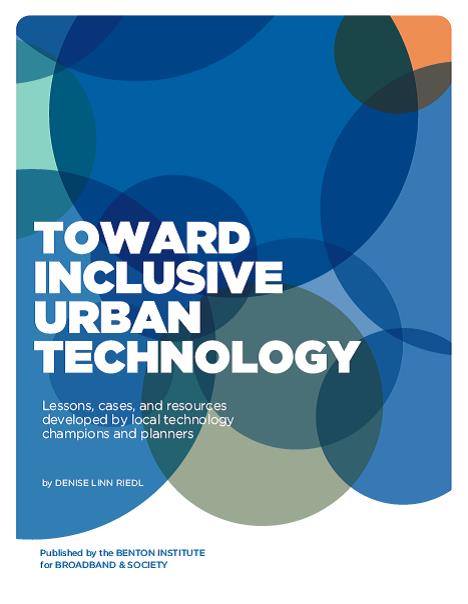Broadband Lessons Learned in 2020
Friday, December 18, 2020
Weekly Digest
Broadband Lessons Learned in 2020
You’re reading the Benton Institute for Broadband & Society’s Weekly Digest, a recap of the biggest (or most overlooked) broadband stories of the week. This week Benton's Executive Director, Adrianne B. Furniss, takes the mic.
Round-Up for the Week of December 14-18, 2020

2020 is not a year we'll want to remember, but it is also a year we'll never forget. For advocates of universal, open, affordable broadband, the tragedies that unfolded this year only increased our resolve: everyone needs to be able to use High-Performance Broadband to survive and thrive in the 21st century.
We can't wait any longer to make universal broadband a reality. We need a national agenda to fill the gaps for those who can't yet access the most important communications technology of our time.
In 2020, the Benton Institute for Broadband & Society released a number of reports with a common goal: to help us better identify the divides that prevent too many from making use of the infrastructure of opportunity, which plays such a vital role in building strong communities.
This past fall, we published Broadband for America Now, a follow up to Broadband for America’s Future: A Vision for the 2020s. When we released that report in 2019, we promised a refresh in 2020 because we knew there were issues that required additional development and more success stories that needed to be told. What we didn't know was how starkly the world would change.
What did not change is the realization that to reach our goal of universal broadband, we need a comprehensive plan based on the following critical building blocks:
- Digital Equity: To achieve a more equitable society, we must make affordable High-Performance Broadband available to low-income, unserved, and underserved populations—and pair it with training in digital skills that empowers users to make the most of their connections.
- Deployment: Broadband infrastructure investment is a necessary economic strategy. There is no reason to saddle any area of the U.S. with second-rate broadband.
- Competition: Americans should not have to pay more merely because public policy has failed to promote competition effectively.
- Community Anchor Institutions: Using broadband to fulfill their missions, community anchor institutions should be able to reach users wherever they are and serve as launching pads for community-wide access.
- Local Leadership: Confronting our digital divides requires bold leadership and informed solutions. Community leadership is key since local governments and anchor institutions are closest to local needs and have earned Americans’ confidence and trust. With the right choices, these are the people and institutions who can link broadband to broader economic and social outcomes and make the greatest impact on their communities.
Benton's other publications this year sought to further illuminate these building blocks.
Open-Access, Middle-Mile Networks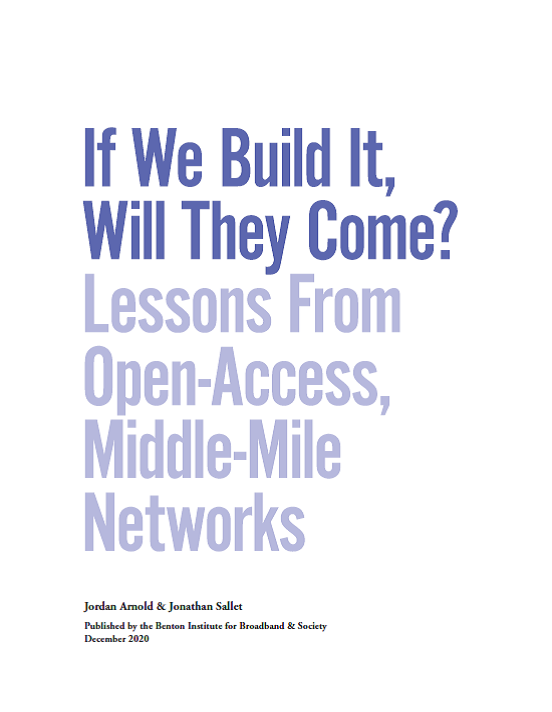
Construction of open-access, middle-mile networks furthers deployment and competition. In If We Build It, Will They Come? Lessons from Open-Access, Middle-Mile Networks, authors Jordan Arnold and Jonathan Sallet explain why and how the federal government should support the construction of open-access, middle-mile networks, and how that support can be structured. They provide background on different kinds of open-access, middle-mile networks across the nation and propose the structure for a federal open-access, middle-mile grant program, incorporating the lessons learned about what boosts the chance for open-access, middle-mile success.
Public Infrastructure/Private Service
How can America’s communities secure the benefits of fiber-optic infrastructure? Joanne Hovis, Jim Baller, David Talbot, and Cat Blake offer one answer in Public Infrastructure/Private Service: A Shared-Risk Partnership Model for 21st Century Broadband Infrastructure: local governments need not accept a binary option of waiting for the private sector to solve the problem—which the private sector already would have done if it made business sense—or taking on the challenge entirely as a public enterprise. The Public Infrastructure/Private Service model puts the locality in the business of building infrastructure, a business cities and counties know well after a century of building roads, bridges, and utilities. The model leaves to the private sector most aspects of network operations, equipment provisioning, and service delivery.
Growing Healthy Digital Equity Ecosystems
Digital inclusion coalitions across the country are responding to the triple challenges we've faced this year: the COVID-19 pandemic, growing economic inequality, and racial injustice facing poor communities and communities of color across the country without access to broadband internet at home. In Growing Healthy Digital Ecosystems During COVID-19 and Beyond, Simmons University researchers Colin Rhinesmith and Susan Kennedy help us better understand the roles these coalitions have played in supporting and shaping the digital inclusion work in local communities to promote more equitable access to technology. The authors suggest that these digital inclusion coalitions, working together with academic researchers, can use their combined strength as a collective to influence policy at the local, state, and national levels to promote and sustain healthy digital equity ecosystems for all.
Adapting Jobs Programs for Today and Tomorrow
Millions have lost employment this year due to stay-at-home orders. Unfortunately, for too many, those jobs may never return. A potential bright sport in the employment marketplace, however, are "middle-skill" jobs. They make up a large portion of the market, have positions to fill, but there's a dearth of trained workers—especially when it comes to digital skills. John Horrigan finds, in Adapting Jobs Programs for Today and Tomorrow, that broadband plays an important role in this sector as a delivery mechanism for jobs training (especially during the pandemic) and as a wraparound service that allows people to coordinate various responsibilities so they have the time to participate in jobs training programs.
Toward Inclusive Urban Technology
Our cities are changing at an incredible pace—a pace that has only been accelerated by our response to the pandemic. The technology being deployed on our sidewalks and streetlights has the potential to improve mobility, sustainability, connectivity, and city services. Public value and public inclusion in this change, however, are not inevitable. Depending on how these technologies are deployed, they have the potential to increase inequities and distrust as much as they can create responsive government services. South Bend (IN) Chief Innovation Officer Denise Linn Riedl convened a coalition of urban technology innovators to answer a complicated question: What does procedural justice look like when cities deploy new technology? Toward Inclusive Urban Technology is a guide meant for any local worker—inside or outside of government—who is helping to plan or implement technological change in their community. It’s a collection of experiences, cases, and best practices that we hope will be valuable and will make projects stronger, more sustainable, and more inclusive.
The strength of High-Performance Broadband is that it will—if fully accessible to all in America—help solve some of our most critical challenges and help people overcome key barriers regardless of where they live and who they are. In 2019, we asked you to imagine each community enabled to identify and build on its strengths and employ technology accordingly. In 2020, we learned that we can't wait any longer to make that happen.
As we end this year and celebrate Benton's 40th anniversary in 2021, we want to acknowledge and thank the many collaborators and allies who contribute to the Benton Institute for Broadband & Society's success. Our researchers and authors, our experts, and our board and staff are poised to enter next year with renewed purpose and energy to address at-home internet access as a civil rights emergency in need of a comprehensive solution.
Best of the Rest
Our Weekly usually ends with links to can't miss stories from the week. I'm taking license with my guest author status to end instead with a list of our top-read stories of 2020. Please do click through for our best analyses over the past year - KT.
- What is the Rural Digital Opportunity Fund?
- The FCC Says It Is All About Closing the Digital Divide. How Is It Doing?
- What's Going on With the FCC's Lifeline Program?
- Everything You Wanted To Know About Broadband (But Were Afraid To Ask)
- Congress Tells FCC to Fix Broadband Maps Now
- Lack of Broadband Leaves Students Behind
- AT&T, FCC Abandon Rural Broadband Customers
- How Does the CARES Act Connect Us?
- America’s Broadband Moment
- The Other Homework Gap: Post-Secondary Education During COVID-19
- The Internet is Not Working for Everyone
- Broadband HEROES
The Benton Institute for Broadband & Society is a non-profit organization dedicated to ensuring that all people in the U.S. have access to competitive, High-Performance Broadband regardless of where they live or who they are. We believe communication policy - rooted in the values of access, equity, and diversity - has the power to deliver new opportunities and strengthen communities.
© Benton Institute for Broadband & Society 2020. Redistribution of this email publication - both internally and externally - is encouraged if it includes this copyright statement.
For subscribe/unsubscribe info, please email headlinesATbentonDOTorg



